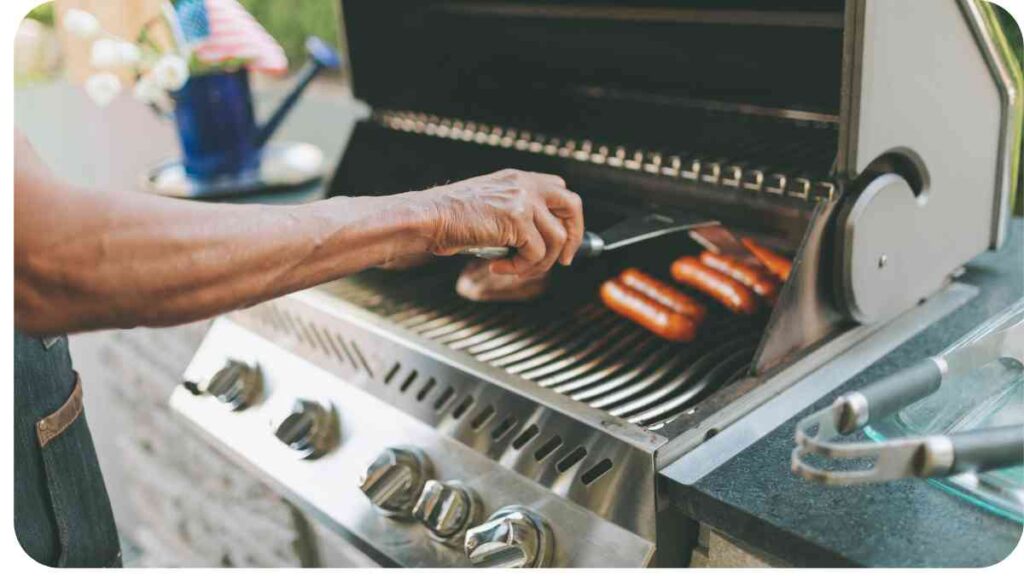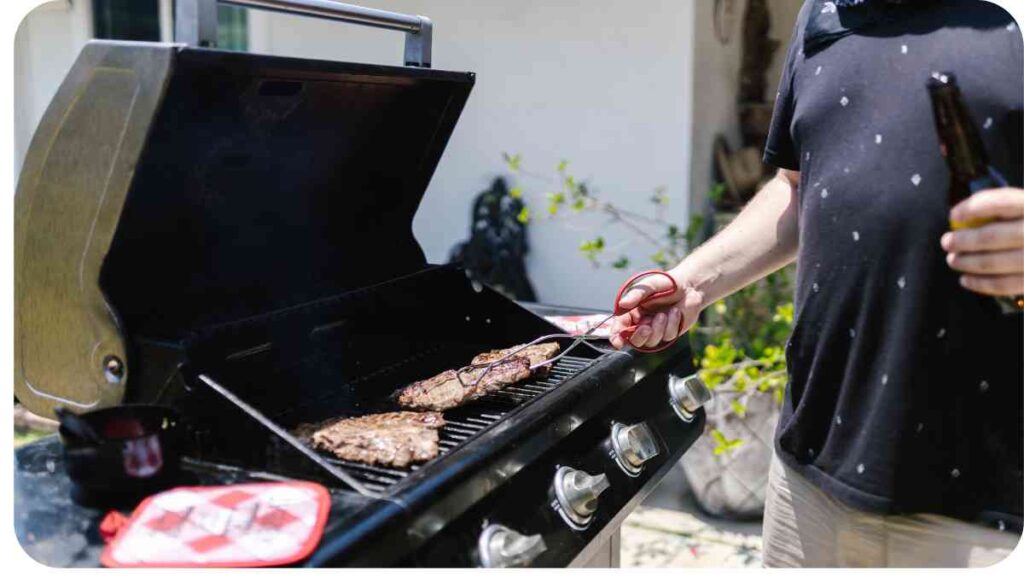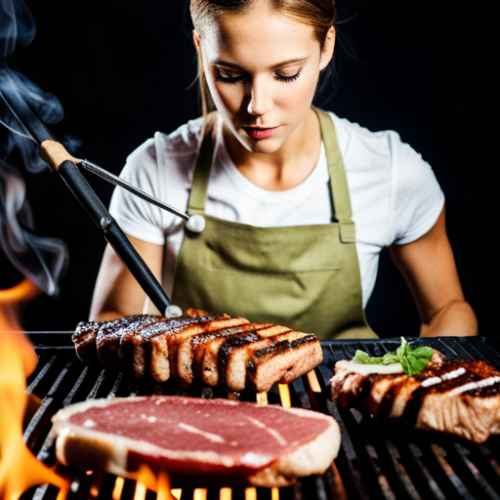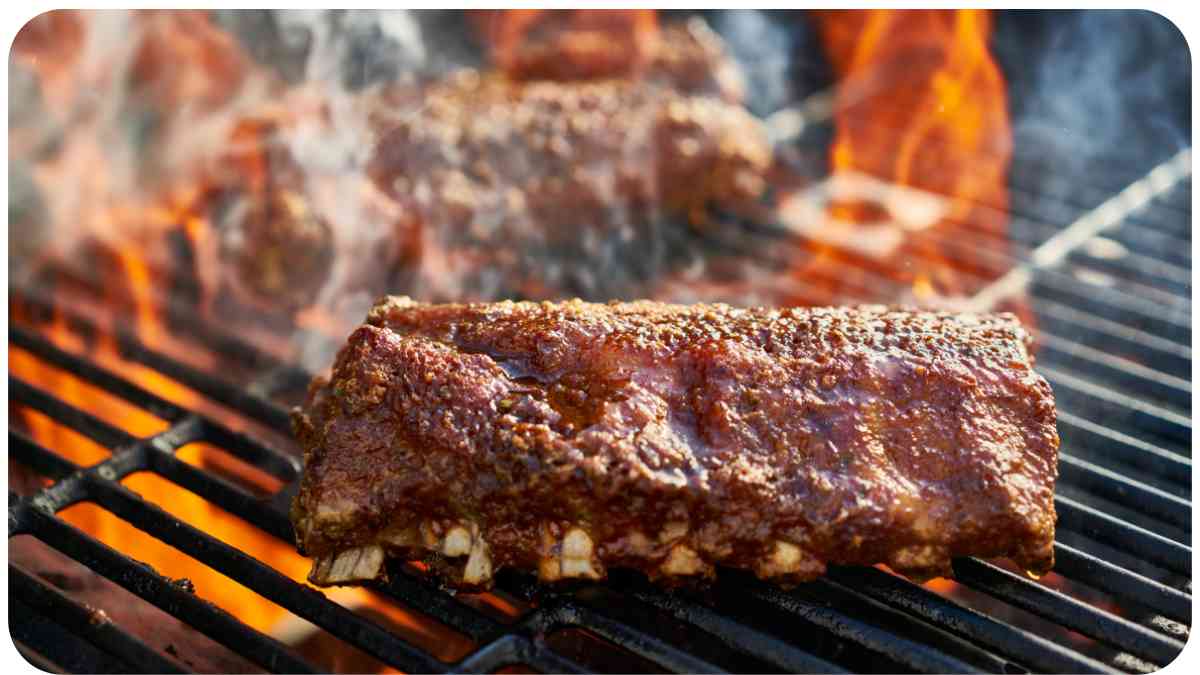There’s nothing quite like the sizzle of a perfectly grilled steak on a warm summer evening. However, achieving that level of culinary perfection requires more than just great ingredients it demands a precisely calibrated grill.
In this comprehensive guide, I’ll walk you through the intricate process of calibrating your Weber grill to ensure that every burger, bratwurst, or vegetable you grill is cooked to perfection.
| Key Takeaways |
| Proper grill calibration ensures consistent cooking outcomes and prevents undercooked or overcooked food. |
| Calibration involves adjusting the burner controls to match the desired temperature settings. |
| Regular cleaning, maintenance, and seasonal adjustments are essential for accurate grill calibration. |
| Weber offers a range of grill models, each with unique features suitable for various grilling needs. |
| External thermometers and oven thermometers can help verify the accuracy of your grill’s built-in thermometer. |
| Calibration issues like uneven heat distribution and inconsistent temperature readings can often be resolved with adjustments. |
| Following the calibration process enhances your grilling experience, leading to perfectly cooked dishes and satisfied guests. |
| Weber’s comprehensive guidebook, “Weber’s Way to Grill,” is a valuable resource for mastering various grilling techniques. |
| Proper grill maintenance extends beyond calibration, including regular cleaning and addressing rust to prolong your grill’s life. |
| Keeping records of calibration adjustments helps create a history of your grill’s performance for future reference. |
Understanding Grill Calibration
What is Grill Calibration?

Grill calibration is the art of fine-tuning your grill’s internal temperature to match the settings on the control panel. Think of it as aligning the stars for a stellar grilling experience. When your grill is calibrated correctly, you can trust that the temperature you set is the temperature you’ll get.
“When considering grill brands, Nexgrill vs. Weber is a common comparison. Discover the strengths and weaknesses of both in this comprehensive guide.”
Why is Calibration Important?
Imagine trying to bake a cake with an oven that’s 50°F too hot – the result would be disastrous. The same principle applies to grilling. Whether you’re searing, smoking, or roasting, accurate calibration ensures consistent cooking outcomes and minimizes the risk of undercooked or overcooked food.
Signs Your Grill Needs Calibration
Table: Signs Your Grill Needs Calibration
| Signs of Calibration Issues | Possible Solutions |
| Uneven grill marks | Adjust burner controls |
| Inconsistent internal temperature | Calibrate temperature probe |
| Longer cooking times | Check for gas flow issues |
Stay tuned as we explore how to address these issues and get your grill back on track.
Tools and Materials You’ll Need
Before we jump into the calibration process, let’s make sure you have everything you need to get started. Here’s a handy list of tools and materials:
- Screwdriver (flathead and Phillips)
- Grill brush
- Cooking thermometer
- Oven mitts
- Cleaning cloths
- Soap and water for cleaning
- Calibration guide (usually provided in your grill’s manual)
Now, let’s roll up our sleeves and dive into the step-by-step calibration process.
“Grilling like a pro is easy with the right knowledge. Explore ‘The Ultimate Grilling Guide’ for expert tips and techniques to elevate your grilling game. Check it out here.”
Step-by-Step Calibration Guide
Preparing the Grill
- Safety First: Always ensure your grill is in a well-ventilated outdoor area and away from any flammable materials.
- Cleaning Time: Give your grill a good cleaning. A clean grill not only prevents cross-flavors but also helps in accurate calibration.
- Empty the Grates: Remove the grates and heat deflectors to access the burners.
Adjusting the Burner Controls
- Check for Gas Leaks: Before you start, ensure there are no gas leaks. Mix soap and water, apply it to the connections, and watch for bubbles. If bubbles appear, there’s a leak that needs fixing.
- Check Ignition: Test the ignition system. If it’s not working, replace it before proceeding.
- Turn on the Grill: Set all burner knobs to the “High” position and ignite the grill.
- Wait for Preheating: Close the lid and let the grill preheat for about 15 minutes. This helps burn off any remaining debris from previous grilling sessions.
Verifying the Temperature Accuracy
- Temperature Probe Calibration: If your grill has a built-in temperature probe, make sure it’s calibrated correctly according to the manufacturer’s instructions.
- Use an External Thermometer: Place an external cooking thermometer on the cooking grates. Close the lid and let it sit for 10 minutes.
- Temperature Discrepancy: Compare the grill’s built-in thermometer reading with the external thermometer’s reading. If there’s a significant discrepancy, it’s time to calibrate.
“Unlock the secrets behind achieving the perfect grilled steak on a Traeger grill. Dive into ‘The Science Behind the Perfect Grilled Steak’ to master this art. Learn more here.”
Table: Temperature Calibration Guidelines
| Discrepancy | Action |
| Higher reading | Adjust burner controls |
| Lower reading | Adjust burner controls |
Common Calibration Issues
Uneven Heat Distribution
One common issue is uneven heat distribution. If you’re noticing uneven grill marks or inconsistent cooking times, your grill might have calibration issues. A quick adjustment to the burner controls can often alleviate this problem.
Inconsistent Temperature Readings
When your grill’s internal temperature doesn’t match the set temperature, your culinary creations could be in jeopardy. Calibrating the temperature probe or adjusting the burner controls can usually solve this.
T – Let’s add a table that showcases a comparison of popular Weber grill models and their features:
| Model | Features |
| Weber Spirit | Compact design, ideal for small spaces |
| Weber Genesis | High-performance burners, advanced options |
| Weber Summit | Top-tier features, multiple burners |
| Weber Q Series | Portable, great for picnics and camping |
Tips for Maintaining Accurate Calibration
- Regular Check-ups: Don’t wait for a major issue to arise. Periodically check your grill’s calibration to catch any deviations early.
- Cleanliness Matters: Keep your grill clean. Grease and debris can affect temperature accuracy.
- Seasonal Adjustments: Extreme weather can impact calibration. Make slight adjustments based on temperature changes.
- Keep Records: Note down any adjustments you make and their outcomes. This helps create a calibration history for your grill.
“Encountering errors with your Pit Boss pellet grill? Don’t worry, there’s a solution. Discover what common Pit Boss pellet grill errors mean and how to fix them right here.”
Expert Insights and Anecdotes
As someone who has spent years in the world of grilling, let me share a personal experience. On a sunny Sunday, I planned an outdoor barbecue for friends and family. To my dismay, the grill seemed to have a mind of its own, resulting in charred sausages and undercooked chicken. I realized the importance of calibration that day, and ever since, I’ve made it a ritual before any barbecue event.
Comparison of Weber Grill Models

Now, let’s take a look at a quick comparison of some popular Weber grill models:
Table: Comparison of Weber Grill Models
| Model | Features |
| Weber Spirit | Compact design, ideal for small spaces |
| Weber Genesis | High-performance burners, advanced options |
| Weber Summit | Top-tier features, multiple burners |
| Weber Q Series | Portable, great for picnics and camping |
Frequently Asked Questions (FAQs)
Table: FAQ About Grill Calibration
| Question | Answer |
| How often should I calibrate my grill? | Aim for at least once a season, but more often if you notice temperature discrepancies. |
| Can I use an oven thermometer for calibration? | Yes, an oven thermometer works well for checking temperature accuracy. |
| My grill’s temperature fluctuates. Why? | Temperature fluctuations can be due to gas pressure, wind, or a faulty regulator. |
Troubleshooting Calibration Problems
Table: Troubleshooting Guide
| Issue | Possible Solution |
| Uneven grill marks | Adjust burner controls or rearrange food placement |
| Temperature fluctuates wildly | Check gas supply, clean burners, adjust regulator |
| Temperature not reaching desired heat | Check for gas flow issues, adjust burner controls |
Beyond Calibration: Extended Grill Care
Maintaining a well-calibrated grill is just one aspect of grill mastery. Regular cleaning and maintenance play a crucial role too.
“Is your Char-Broil grill failing to heat up as expected? Find troubleshooting tips to resolve the issue effectively. Learn more about ‘Why Your Char-Broil Grill Isn’t Heating Up’ here.”
Cleaning and Maintenance Tips
- After Every Use: Scrape the grates with a grill brush to remove food debris.
- Monthly Cleaning: Give your grill a deep clean by removing and cleaning the grates, burners, and heat deflectors.
- Check for Rust: Keep an eye out for rust and address it promptly to prevent corrosion.
- Cover it Up: Invest in a good-quality grill cover to protect your grill from the elements.
Table: Cleaning Schedule for Weber Grills
| Cleaning Task | Frequency |
| Scrape grates | After every use |
| Deep clean (grates, burners, heat deflectors) | Monthly |
| Check for rust | Every 2-3 months |
Conclusion
In the world of grilling, precision matters. Your Weber grill, with its exceptional design and features, deserves the utmost attention to calibration. By following this comprehensive guide, you’ll not only master the art of calibration but also elevate your grilling game to new heights. Remember, a well-calibrated grill is the secret behind those mouthwatering steaks and juicy burgers that will have your friends and family coming back for more. Happy grilling!
With this, we conclude our comprehensive guide to Weber grill calibration. May your grilling adventures be filled with sizzling success!
Feel free to refer back to this guide whenever you need to fine-tune your grilling experience. Happy grilling!
Further Reading
For more in-depth information and resources on Weber grill calibration, check out these links:
- Weber Grill Manuals: Access official Weber grill manuals for detailed calibration instructions and maintenance tips.
- Weber Grill Model 46510001 Manual: Get specific calibration guidance for the Weber grill model 46510001.
- Weber’s Way to Grill: Dive into the world of grilling with this comprehensive guide by Weber, covering various grilling techniques and tips.
FAQs
Have some burning questions about Weber grill calibration? We’ve got you covered. Here are some frequently asked questions:
How often should I calibrate my Weber grill?
Calibrate your Weber grill at least once every grilling season to ensure accurate temperature control and consistent cooking results.
Can I use an oven thermometer for grill calibration?
Yes, using an oven thermometer is a practical way to check the accuracy of your grill’s built-in thermometer. Place both thermometers in the grill and compare the readings.
What should I do if my grill’s temperature fluctuates during cooking?
Temperature fluctuations can result from various factors, including gas pressure, wind, or uneven burner performance. Ensure proper gas flow and consider shielding the grill from wind for more stable temperatures.
Why is my grill not reaching the desired heat even after calibration?
If your grill isn’t reaching the desired heat level even after calibration, check for gas flow issues, clogs in the burners, or a faulty regulator. Addressing these issues can help restore proper temperature control.
Is it normal for my grill’s temperature to vary across different parts of the cooking grates?
Some temperature variation across the grates is normal due to the design of the grill and the positioning of the burners. To mitigate this, consider rotating the food during cooking for even results.
What’s the best way to clean my grill to maintain accurate calibration?
Regular cleaning is essential for maintaining accurate calibration. After each use, scrape the grates to remove food debris. Perform a deeper cleaning monthly by removing and cleaning the grates, burners, and heat deflectors.
Feel free to explore these FAQs for quick answers to your grill calibration queries. If you have more specific concerns, consult your grill’s manual or reach out to Weber’s customer support for expert assistance.

Hi there! I’m Hellen James, and I’m a grilling enthusiast. I’ve been grilling for years, and I absolutely love it. I love how it brings people together and how you can feed your family with just a few minutes of work.

